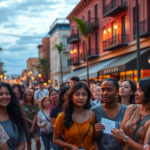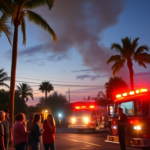Baltimore Drivers Ranked Third Riskiest in Nation, Report Reveals: Implications for the Rio Grande Valley
In a startling revelation that underscores the need for road safety awareness, a recent report has ranked drivers in Baltimore as the third riskiest in the United States. While the findings primarily focus on the streets of Baltimore, the implications resonate far beyond, including in regions like the Rio Grande Valley (RGV) where road safety remains a pressing concern. This report serves as a vital reminder for Valley residents and officials to assess traffic conditions and enhance safety measures in South Texas.
Understanding the Report
The report, which analyzed a combination of accident frequency, fatalities, and traffic violations, placed Baltimore among the top cities with perilous driving conditions. While specific data about the RGV is not included in the report, the information offers a sobering perspective that can be leveraged by local policymakers to preemptively address similar issues in the Valley.
“Data like this is crucial for us because it provides a comparative benchmark,” said Officer James Padre, a spokesperson for the Texas Department of Public Safety in the RGV. “It helps us evaluate our traffic systems and improve compliance, making the roads safer for our community.”
Local Impact: Lessons for Rio Grande Valley
While Baltimore’s ranking has no direct correlation to the RGV, it sheds light on the importance of continued vigilance regarding traffic safety. Local authorities have consistently worked to keep road safety a priority, but the report highlights the need to maintain and possibly intensify those efforts.
Joe Alvarez, a Harlingen resident and avid community advocate, expressed his views on the issue. “Driving conditions in the RGV can sometimes be challenging with our urban and rural mixes. We must continually look to other cities and learn from their challenges to prevent similar issues from arising here,” he said. Valley residents often face a mix of heavy traffic in urban areas and less monitored roads in rural settings, increasing the complexity of ensuring consistent road safety.
Connections to Previous Local Events
The RGV has had its share of road safety concerns, with high-profile incidents reaffirming the need for stringent measures. The tragic accident on Interstate 2 last year that claimed several lives brought the issue into sharp focus, prompting local government to enhance traffic control measures and increase patrols.
“Every incident is a wake-up call,” remarked Marisa Chavez, a public health expert at the University of Texas Rio Grande Valley. “We must leverage data and insights from national reports like this to make strategic decisions locally.”
Future Implications and Strategies
Looking ahead, the report from Baltimore offers RGV officials a framework to reevaluate and strengthen road safety protocols further. Implementing more comprehensive driver safety programs, increasing the visibility of law enforcement on highways, and enhancing public education about safe driving practices could mitigate accidents and risks.
The report also suggests potential opportunities for community involvement in advocating for safer roads. Initiatives could include local workshops on road safety, simulations for driver education, or partnerships with schools to engage younger generations in being proactive about traffic laws.
Balanced Perspectives on Road Safety Initiatives
Opinions on how to tackle road safety vary, with some advocating for technological solutions such as the deployment of smart traffic systems. Others suggest that traditional community-based awareness campaigns remain indispensable.
Mike Rodriguez, a transportation consultant often engaged with local projects, believes a balanced approach is necessary. “Technology can augment our traditional methods, offering real-time data and automated enforcement mechanisms. But it’s our community’s values and cooperation that will keep our streets safe,” he opined.
Community Resources and Next Steps
For Valley residents interested in contributing to road safety, several resources are available. The RGV Transportation Planning Organization offers regular updates on traffic patterns and safety measures. Residents can also contact the local DPS office to report unsafe driving or suggest improvements.
In closing, while Baltimore’s ranking as one of the riskiest driving cities might initially appear disconnected from South Texas issues, it provides a crucial opportunity for the Rio Grande Valley to reflect on and refine its own road safety strategies. By leveraging insights from national reports, engaging community interest, and fostering a culture of safety, RGV leaders can ensure that Valley roads remain safe for all its residents.







